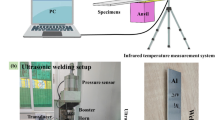Abstract
Structure of 1-mm tungsten (W) coating on copper (Cu) with the different compliant layers was designed and optimized by means of ANSYS code. Three materials of titanium, nickel-chromium-aluminum alloys, and W/Cu mixtures with a thickness of 0.5 mm were selected as the compliant layers to evaluate their effects on the interface stress between W and Cu, strain, and the surface temperature under the heat load of 5 MW/m2. Application of the compliant layers can obviously alleviate the interface stress concentration compared to the sharp interface. The maximum stress reduction of about 25% was obtained from the W/Cu-compliant layer; however, the surface temperature was increased only by 12 °C. Further investigation on the W/Cu-compliant layer revealed that 0.1-0.2-mm 20-35 vol.% W was the optimum structure for 1-mm W coating, which resulted in the smallest peak stress of 299 MPa and the equivalent plastic strain of 0.01%.






Similar content being viewed by others
References
R. Montanari, B. Riccardi, R. Volterri et al., Characterisation of Plasma Sprayed W Coatings on a CuCrZr Alloy for Nuclear Fusion Reactor Applications, Mater. Lett., 2002, 52, p 100-105
M. Roedig, W. Kuehnlein, J. Linke et al., Investigation of Tungsten Alloys as Plasma Facing Materials for the ITER Divertor, Fusion Eng. Des., 2002, 61-62, p 135-140
F.L. Chong, J.L. Chen, and J.G. Li, Evaluation of Tungsten Coatings on CuCrZr and W/Cu FGM Under High Heat Flux and HT-7 Limiter Plasma Irradiation, J. Nucl. Mater., 2007, 363-365, p 1201-1205
J. Matejicek, Y. Koza, and V. Weinzettl, Plasma Sprayed Tungsten Based Coatings and Their Performance Under Fusion Relevant Conditions, Fusion Eng. Des., 2005, 77-79, p 395-399
ITER Materials Properties Handbook, ITER Document No. G 74 MA 10 01-10-11 W 0.2
Y. Itoh, M. Takahashi, and H. Takano, Design of Tungsten/Copper Graded Composite for High Heat Flux Components, Fusion Eng. Des., 1996, 31, p 279-289
M.G. Yin and L. Chao, The properties of Ti and Ti alloys and its equipment application, Chem. Ind. Equip. Technol., 2006, 27(5), p 55-58
W. Lu, W. Fuchi, L. Guangshu et al., Residual Thermal Stress for the Interface in ZrO2-NiCrAl Functionally Gradient Thermal Barrier Coatings, J. Beijing Inst. Technol., 1998, 18(5), p 630-633
Acknowledgments
This study was supported by the National Natural Science Foundation of China under Project No. 11205130.
Author information
Authors and Affiliations
Corresponding author
Rights and permissions
About this article
Cite this article
Chong, F. Optimization of Plasma-Sprayed Tungsten Coating on Copper with the Heterogeneous Compliant Layer for Fusion Application. J Therm Spray Tech 22, 57–60 (2013). https://doi.org/10.1007/s11666-012-9869-4
Received:
Revised:
Published:
Issue Date:
DOI: https://doi.org/10.1007/s11666-012-9869-4




